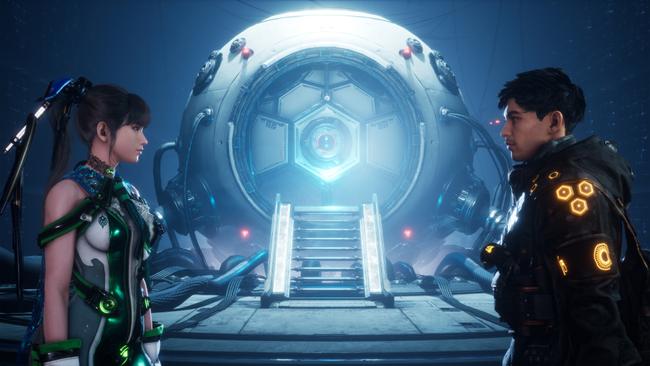
Stellar Blade Review
As I rolled the credits on Stellar Blade, after about fifty-odd hours playing the game - thirty or so in the main story and another twenty and change to clear out most of the game's side quests - I realized that I never did understand why the game is called Stellar Blade. Its main character wields a wicked sword most of the time, sure, but outside of a few offhand references to starry skies in the costume descriptions, she has little to do with space or the stars. The game's original placeholder title, Project EVE, seemed more relevant, at least, since that's her name. Then I remembered another thing: It's sometimes more important to be cool and stylish than to make sense, an outlook demonstrated with gusto by Stellar Blade itself, much to its benefit.
Looking cool and stylish can be interpreted as a core goal, in fact, for Stellar Blade. Developer Shift Up - better known for mobile titles like Goddess of Victory: NIKKE - created Stellar Blade with the objective of making a big splash with its first major console game, and it shows: Stellar Blade boasts some of the best character graphics I've seen on the PS5 to date. The game and its characters are extremely pretty in every sense of the word. Every move EVE makes in combat is lovingly rendered, with graceful and balletic animations underscoring the combat. Even her ankle-length ponytail flicks and trails realistically, as if it were demonstrating some new hair physics technology.
The Naytiba monsters EVE slaughters are given seemingly equal attention, and don't lack for variety and detail. The dozens of available monsters to fight all squelch, squeeze, and skitter around in a fittingly gross and alien manner, while later-game hybrids of machine and flesh exude a sense of intimidating threat. Though it makes me sound like a psychopath to write down, it was a pleasure to cut them apart with EVE's various moves and combos, as well as to learn how they telegraphed their attacks, the better to set up for perfectly timed parrying and evasion.
There's a strong "beauty and the beast" vibe to Stellar Blade's aesthetic, and Shift Up has leaned in hard on the contrast. EVE herself is rendered like a video game bombshell idol on par with the likes of 2B from NieR: Automata or Bayonetta, with a clear amount of effort and expense spent to making her look beautiful at all times. EVE is never not at the center of the action, and with virtually every other character left as a voice emanating from her floating companion drone - which also serves as a convenient firearm.
Shift Up had no qualms about revolving the game around the idea of EVE as an almost superhumanly attractive centerpiece character, and crafted dozens of outfits (called "Nano Suits") to earn and dress her with. The outfits themselves run along a wide range of designs, ranging from tight, shiny bodysuits with eyebrow-raising cutouts, to more practical-looking sports and daywear ensembles and even jokey full-body mascot costumes. One can even unlock a hair salon in Xion and pick from a range of hair styles, though bizarrely, all of them incorporate a ponytail regardless of whether or not it makes sense, because that's where EVE draws her sword from. The one costume that covers EVE's head entirely also sports the 'tail!
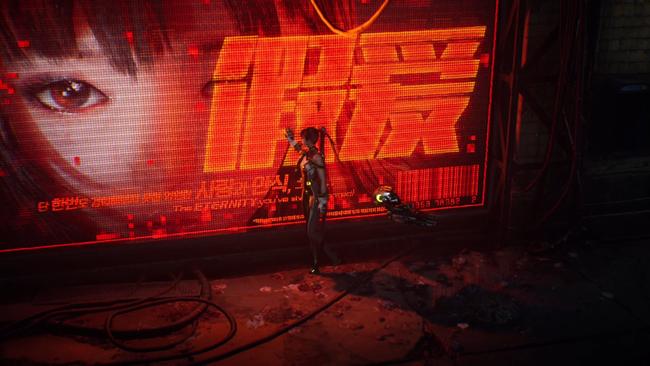
Stellar Blade's narrative is solid but predictable. As revealed in the game's playable demo, EVE is one of many "Airborne Squad" soldiers dropped onto the ruined surface of Earth to locate and destroy the fearsome "Alpha Naytiba," and in doing so, reclaim the planet in the name of Mother Sphere, the all-powerful AI that rules the orbital colony humanity retreated to when the Naytiba took over. Things go poorly during the drop, and all of EVE's comrades, including her commander Tachy, are massacred before the tutorial is even done. Left alone to accomplish her mission, EVE is rescued by Adam, a lowly scavenger fro Xion, Earth's last inhabited city. With help from Adam and Lily, an Airborne Squad engineer, EVE must find several "Hyper Cell" devices needed to empower a cybernetic oracle to locate the Alpha Naytiba and allow EVE to accomplish her task.
If you're familiar with sci-fi, watched a decent amount of anime, or played NieR: Automata - a title Stellar Blade Director Kim Hyung-tae cited as a major inspiration - you'll see the next story beats coming from miles away. But being unoriginal isn't the problem. Instead, the issue is that the storytelling and characterization of Stellar Blade is so low-key it's almost absent for three quarters of the game's runtime. And during that time, EVE remains almost devoid of personality. Outside of her determination to finish her mission and a general sadness of losing Tachy in the introductory sequence, just about the only bit of character EVE shows is that she's not fond of swimming or getting wet. For all of the attention that's been paid to EVE's curves, both inside the game and among those discussing Stellar Blade in the real world, it's kind of a shame, then, that EVE herself comes across as very "flat."
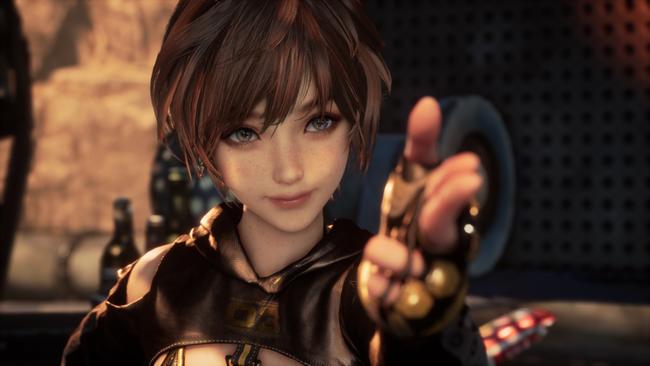
On paper, EVE's lack of character might align with some of the game's themes about what it means to be human, but even that minimalistic characterization is inconsistent. EVE's reactions to plot developments and the world around her (when Shift Up bothers to put them onscreen) fluctuate between "naive ingenue," "robot struggling to comprehend emotion," and "hardened soldier focused on the mission." Her interactions with Adam and Lily imply an bond and history that isn't rooted anywhere in the game that players can see, and even at their most dramatic, rarely amount to more than a blandly reactive trickle of banter to make it seem like EVE isn't entirely alone in a post-apocalyptic landscape.
Despite the fact that its main plot feels terminally underwritten, Stellar Blade is paradoxically overwritten in the margins. The game contains dozens upon dozens of small bits of written lore in the form of collectible text pickups scattered throughout the game world. Some bits feature intriguing doses of backstory that complicate the plot's premises, such as filling out the strange religious edge to the game's treatment of Mother Sphere, or traces of a budding resistance movement to Mother Sphere and her agents' authority (including EVE).
One of the game's endings even depends on collecting the larger portion of lore drops, running on the premise that this additional world knowledge and experience brings EVE a new understanding of the world she fights for. But the vast majority of these lore pickups are the functional equivalent of deathbed graffiti, adding little beyond painting a bleak picture of life for those who aren't superpowered soldiers born to kill in the name of Mother Sphere.
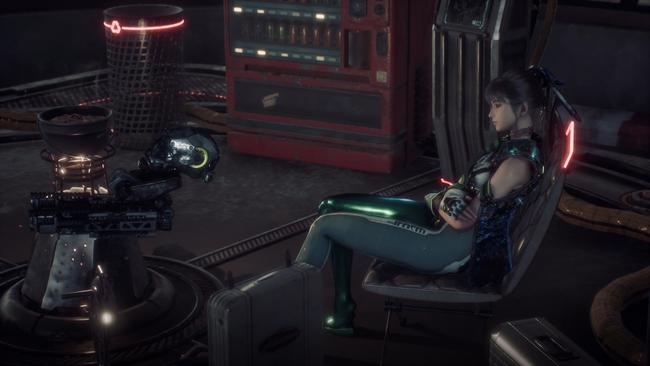
It also doesn't help that the English-language script comes across as stilted and stiffly written. While Stellar Blade is in many ways a post-human Korean-style cyberpunk story, I doubt Shift Up's intent was to have everyone speak like a robot. As a player of NIKKE, whose English localization has a largely excellent grasp of tone and character voice, I found this blandness rather perplexing to see in a project that, for all intents and purposes, Shift Up is using as a demonstration of the company at the top of its craft.
Things really only seem to find their stride in the game's final act, when a proper set of stakes is introduced as players roll up to one of the game's multiple endings. Having a strong finish is good, but when the rest of the narrative is so weak, one can see that some players might struggle to care enough to make it to the finish line.
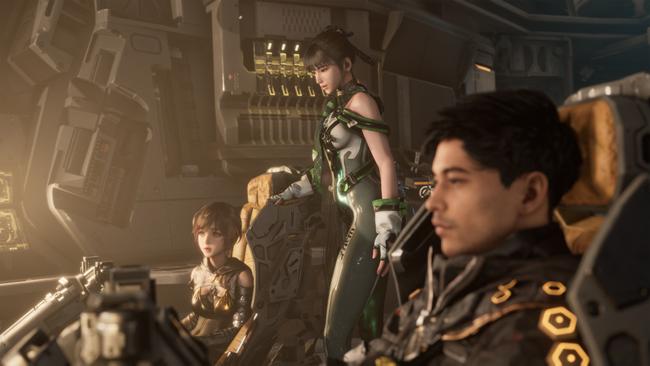
As disappointing as a blandly delivered story can can be, style and combat are the ultimate bread and butter of a high-end action RPG, and Stellar Blade's fights carry more than enough weight to compensate for the narrative's shortcomings. While Shift Up has cited NieR: Automata as an inspiration, Stellar Blade's combat system owes more to From Software, particularly Sekiro: Shadows Die Twice. EVE's fights against enemies large and small carry a particular emphasis not on wild button-mashing but careful timing, with a heavy emphasis on landing perfect parries and dodges. EVE can still whale away at enemies with light and heavy attacks mapped to the face buttons, but it's in parrying and dodging that the system truly shines.
Enemies will often launch into very long attack strings and can output pretty high damage, which EVE will eat entirely if she doesn't do her best to parry or dodge through the entire combo. Foes also signal their attacks with color-coded visuals. An enemy the glows yellow must be dodged alone, but one that glows blue or pink opens itself up to a different form of powerful riposte, one form of which uses EVE's guns to blast away at their suddently exposed weak points. EVE can even call on not one but two whole categories of powerful trump card: The Beta Attack and the Burst Attack. The Beta Gauge is charged by landing attacks and pulling off perfect parries. Beta Attacks are strong hits that can be upgraded in the skill menu to have various secondary effects like stuns and knockdowns. Meanwhile, Burst Attacks are only charged by perfect dodges, and contain even harder-hitting, almost screen-clearing cinematic supers.
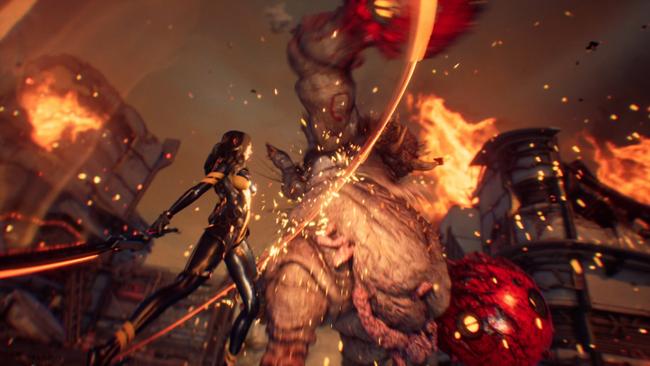
This deadly dance plays out repeatedly over a game world that emphasizes scale, exploration, and variety. The opening hours of Stellar Blade, spent in the derelict city of Eidos 7, closely resemble a light, flashy version of a Souls game. Players will navigate EVE through the ruins without access to any more guidance than memory and a compass heading. They'll move between camp checkpoints, unlocking shortcuts that turn levels into convenient loops, and fight monsters carefully positioned for jump scares and to pressure EVE into dying, upon which all enemies respawn.
But after leaving Eidos 7, things take a turn into territory more resembling a more traditional open-world game. Two of the game's playable maps are massive, littered with checkpoints, collectibles, and side quests. Scouring these maps clean of side quest icons will take up the majority of playtime outside the plot, but it never quite descends into tedium, thanks to the threatening qualities of the enemies and the excellent world and landscape design. Each corner of the game world brims with little unmarked challenges, ranging from things as mundane as small chests of resources or lore pickups to bespoke movement challenges that, sometimes, can't even be surpassed until EVE unlocks more movement options in the back half of the campaign.
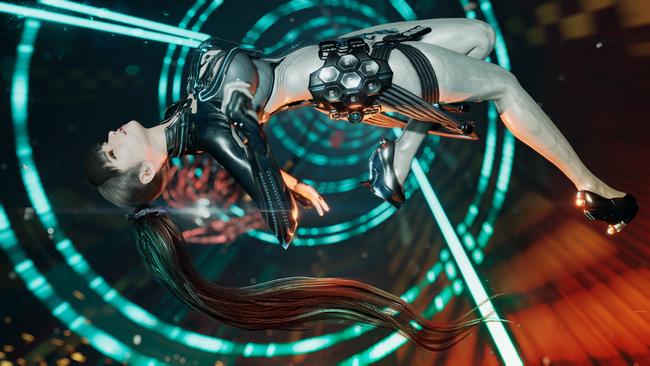
Little bits of unique character poke through the world design of otherwise generic-seeming post-apcalyptic desert environments, like the way the larger waypoint camps always have a simmering pot of Jjigae stewing over the fire, a record player blaring relaxing tunes. Robot drones that ply hidden areas waiting to be killed for their treasure are designed like inflatable balloons teetering on spindly metal legs. EVE can unlock the game's skimpiest outfit by finding a series of collectible soda cans, and she displays them with a winsome smile and commercial-perfect pose when picking them up. It's details like this that add a sense of personality and life to Stellar Blade that I found myself sorely wishing the story and characters would match.
Narrative nitpicks and shortfalls aside, Stellar Blade is an action RPG that excels where it matters most: Looking gorgeous and facilitating supremely satisfying combat interactions. Bolstered by the capable fusion of its inspirations, its weaknesses keep it from transcending them. But those willing to make their peace with those disappointments will find a nearly stellar experience.
